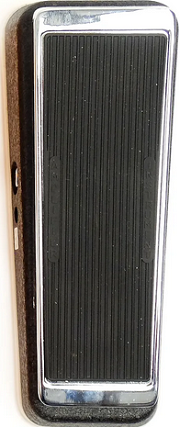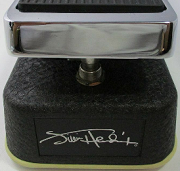Difference between revisions of "JH1B Hendrix Wah"
m |
|||
| (10 intermediate revisions by the same user not shown) | |||
| Line 2: | Line 2: | ||
| __TOC__ | | __TOC__ | ||
|} | |} | ||
| − | Dunlop JH1B Hendrix Wah | + | The [[Dunlop]] JH1B Hendrix Wah may have Jimi Hendrix's name on it, but that's because the Jim Dunlop company pays a licensing fee to the Hendrix estate. On the other hand, Jimi, it seems, owned and used a number of [[Vox]] 846 wah-wah pedals. This is not so difficult to [https://scottsdale.com/local-spotlight/jimi-hendrixs-wah-wah-pedal-and-amp-in-j-levines-new-years-day-auction look up and find out]. |
| + | |||
| + | So all it really took for Jim Dunlop to make the Crybaby "authentic Jimi Hendrix" was some licensing fees, a chrome treadle on a black base, and white trim. The Crybaby "Hendrix" wah is very similar to the Vox - the main differentiator being the Vox logo that runs up-and-down the face of the treadle. | ||
| + | |||
| + | The real secret is that in 1967 when the Thomas Organ company invented the Wah-wah, they had a Vox-branded market to cater to, but also sold into other markets under the "Crybaby" name. Thomas Organ sold BOTH the Vox Wah and the Crybaby, setting up a fake rivalry between the two pedals that only served to highten awareness of the Wah-wah. However, Thomas also failed to enforce their patent for the wah-wah, and soon wah-wah pedals of all different kinds of makes and brands were being sold around the world. | ||
| + | |||
| + | Electronic components may have changed over time, but the circuit architecture of the wah-wah circuit remains remarkably similar to the wah circuit Brad Plunkett developed for Thomas back in 1967. So despite Jimi Hendrix never having played a "Thomas Organ-branded Crybaby wah-wah, the Vox and the Crybaby were (and are) essentially the same. | ||
| + | |||
| + | The latest version of the "authentic Jimi Hendrix" wah by Dunlop is the JH1D. Instead of a chrome treadle it has a black one along with the black base. We think the chrome treadle looks smarter, but the truth of the matter is that the color of your pedal won't make any difference how your pedal sounds. | ||
| + | |||
| + | * '''Thermionic Studios has two(2) JH1B Hendrix Wahs available for rental''' | ||
| + | * '''However, they may get cannibalized for other Wahs or treadle-controlled effects''' | ||
==Controls== | ==Controls== | ||
| − | [[File:Dunlop_JH1B_front.png|right|frame]] | + | [[File:Dunlop_JH1B_front.png|right|frame|<div style="text-align:right">Image from random eBay auction</div>]] |
| − | [[File:Dunlop_JH1B_top.png|right|frame]] | + | [[File:Dunlop_JH1B_top.png|right|frame|<div style="text-align:right">Image from [https://reverb.com/item/6975195-dunlop-jh-1b-hendrix-wah-owned-by-j-mascis J Mascis' Reverb.com shop]</div>]] |
| + | * Footswitch - '''"On/Off":''' Toggles the pedal between active (on) and bypassed (off). | ||
| + | * Treadle - '''"Wah":''' Sweeps the voicing of the wah effect. | ||
| + | |||
| + | ===On-and-Off=== | ||
| + | There are a few different kinds of Wah-wah pedals that use different on/off mechanisms. Most Dunlop wah-wahs use the original Thomas Organ method to turn the pedal on-and-off. | ||
| + | |||
| + | This is done by way of a push-button footswitch under the treble (or toe-down) throw of the treadle. To turn the wah-wah on and off, you must depress the treadle on the toes-side (vs the "heel-side") of the wah. Once the throw of the pedal has been reached, then press the toe-down even harder. Most wah-wahs with a toe-down toggle switch have a felt pad under the treble side of the treadle. To ensure you're toggling the pedal correctly press down the toe-down side of the treadle, and keep pressing until you feel a "click" through the treadle. This may require more of a jerking motion, rather than a smooth one, but its very easy to understand the operation after a few such trial runs. | ||
| + | |||
| + | Wah-wah pedals have also become really fine-tuned over the past 40 years they've existed and this tends to make the toe-down "on-and-off" function a relatively easy thing to do. | ||
| + | |||
| + | ==="A-Owww" vs "Wah"=== | ||
| + | When engaged, rocking the treadle from toe-down to heel-down will result in an "A-Owww" kind of sound. Conversely rocking the treadle from heel-down to toe-down will result in an "Wah" type of sound. | ||
| + | |||
| + | ==Bypass:Buffered== | ||
==General Information== | ==General Information== | ||
| + | The JH1B is almost exactly the same as Dunlop's GCB-95 "generic" wah-wah with the following differences: | ||
| + | |||
| + | * The ”sweep” capacitor is 0.022uF, just like in the JH-1/JH-1D (stock GCB-95: 0.01uF) | ||
| + | * The gain resistor for Q1 is 470 ohms rather than the 390 ohms we find in the GCB-95 and JH-1/JH-1D | ||
| + | If you have a standard Dunlop GCB-95, making those two changes, will make your wah-wah exactly like an "authentic Jimi Hendrix". | ||
==Pedal Manual== | ==Pedal Manual== | ||
| Line 23: | Line 53: | ||
==Artists== | ==Artists== | ||
| − | + | We are currently unaware of any artists actively using the pedal now, or who have in the past. | |
| + | <div style="column-count:3;-moz-column-count:3;-webkit-column-count:3"> | ||
| + | </div> | ||
---- | ---- | ||
;Additional Sources | ;Additional Sources | ||
| − | + | * https://www.musicradar.com/reviews/guitars/vox-v846-hw-532298 | |
| + | * http://stinkfoot.se/archives/2138 | ||
[[Category:Pedals]] | [[Category:Pedals]] | ||
[[Category:Wah-wah Pedals]] | [[Category:Wah-wah Pedals]] | ||
[[Category:Filter Pedals]] | [[Category:Filter Pedals]] | ||
| − | [[Category:Dunlop Pedals]] | + | [[Category:Treadle Pedals]] |
| + | [[Category:Dunlop/MXR Pedals]] | ||
[[Category:Thermionic Pedals]] | [[Category:Thermionic Pedals]] | ||
Latest revision as of 09:25, 30 November 2019
The Dunlop JH1B Hendrix Wah may have Jimi Hendrix's name on it, but that's because the Jim Dunlop company pays a licensing fee to the Hendrix estate. On the other hand, Jimi, it seems, owned and used a number of Vox 846 wah-wah pedals. This is not so difficult to look up and find out.
So all it really took for Jim Dunlop to make the Crybaby "authentic Jimi Hendrix" was some licensing fees, a chrome treadle on a black base, and white trim. The Crybaby "Hendrix" wah is very similar to the Vox - the main differentiator being the Vox logo that runs up-and-down the face of the treadle.
The real secret is that in 1967 when the Thomas Organ company invented the Wah-wah, they had a Vox-branded market to cater to, but also sold into other markets under the "Crybaby" name. Thomas Organ sold BOTH the Vox Wah and the Crybaby, setting up a fake rivalry between the two pedals that only served to highten awareness of the Wah-wah. However, Thomas also failed to enforce their patent for the wah-wah, and soon wah-wah pedals of all different kinds of makes and brands were being sold around the world.
Electronic components may have changed over time, but the circuit architecture of the wah-wah circuit remains remarkably similar to the wah circuit Brad Plunkett developed for Thomas back in 1967. So despite Jimi Hendrix never having played a "Thomas Organ-branded Crybaby wah-wah, the Vox and the Crybaby were (and are) essentially the same.
The latest version of the "authentic Jimi Hendrix" wah by Dunlop is the JH1D. Instead of a chrome treadle it has a black one along with the black base. We think the chrome treadle looks smarter, but the truth of the matter is that the color of your pedal won't make any difference how your pedal sounds.
- Thermionic Studios has two(2) JH1B Hendrix Wahs available for rental
- However, they may get cannibalized for other Wahs or treadle-controlled effects
Controls

- Footswitch - "On/Off": Toggles the pedal between active (on) and bypassed (off).
- Treadle - "Wah": Sweeps the voicing of the wah effect.
On-and-Off
There are a few different kinds of Wah-wah pedals that use different on/off mechanisms. Most Dunlop wah-wahs use the original Thomas Organ method to turn the pedal on-and-off.
This is done by way of a push-button footswitch under the treble (or toe-down) throw of the treadle. To turn the wah-wah on and off, you must depress the treadle on the toes-side (vs the "heel-side") of the wah. Once the throw of the pedal has been reached, then press the toe-down even harder. Most wah-wahs with a toe-down toggle switch have a felt pad under the treble side of the treadle. To ensure you're toggling the pedal correctly press down the toe-down side of the treadle, and keep pressing until you feel a "click" through the treadle. This may require more of a jerking motion, rather than a smooth one, but its very easy to understand the operation after a few such trial runs.
Wah-wah pedals have also become really fine-tuned over the past 40 years they've existed and this tends to make the toe-down "on-and-off" function a relatively easy thing to do.
"A-Owww" vs "Wah"
When engaged, rocking the treadle from toe-down to heel-down will result in an "A-Owww" kind of sound. Conversely rocking the treadle from heel-down to toe-down will result in an "Wah" type of sound.
Bypass:Buffered
General Information
The JH1B is almost exactly the same as Dunlop's GCB-95 "generic" wah-wah with the following differences:
- The ”sweep” capacitor is 0.022uF, just like in the JH-1/JH-1D (stock GCB-95: 0.01uF)
- The gain resistor for Q1 is 470 ohms rather than the 390 ohms we find in the GCB-95 and JH-1/JH-1D
If you have a standard Dunlop GCB-95, making those two changes, will make your wah-wah exactly like an "authentic Jimi Hendrix".
Pedal Manual
Phase Inversion
Schematic
Artists
We are currently unaware of any artists actively using the pedal now, or who have in the past.
- Additional Sources
